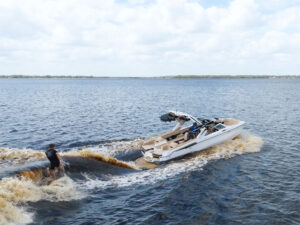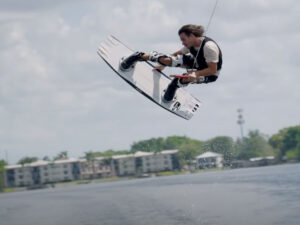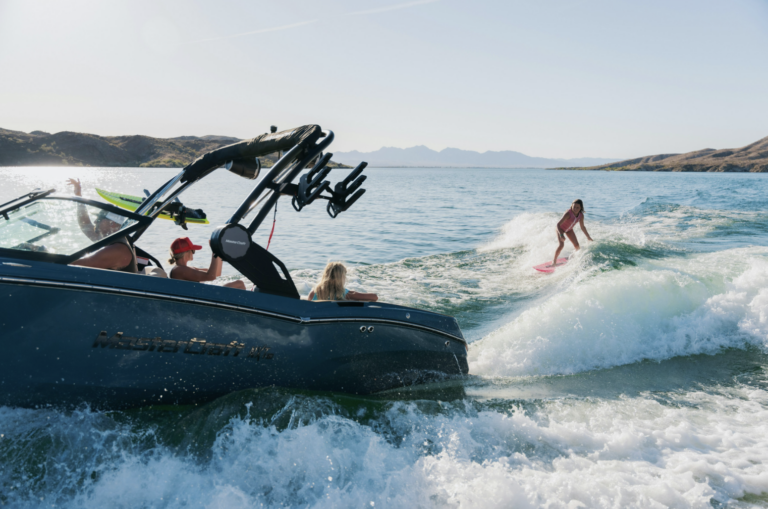Long before compression molding, the legends of our sport were producing prototypes out of what was available at the time; primarily surfboard materials. These early pioneers were shaping the foundation for what we now call wakeboards. Today, there are many different schools of board building. There are engineers, surfboard shapers and wakeboarders all making sticks, and one is not necessarily more qualified or better suited than another for building wakeboards. All are equally impressive to talk with about their designs, all make boards for different reasons, and the end product is something that is very subjective. One thing is obvious: Production wakeboards, utilizing compression molds, have decreased the demand for their hand-shaped siblings, but rest assured, custom boards aren’t a thing of the past.
Compression molds have allowed the manufacturers to increase strength and productivity, thereby decreasing cost and weight. However, there are some custom builders that remain remarkably competitive; and more specifically, they claim to be able to match and even surpass the quality and performance of the mega manufacturers. If you weren’t used to either, which do you think would feel better? Even if you think your production board is the bomb, aren’t you curious to try something you may like better?
Hand-shaped boards are also an essential part of manufacturers’ R&D, so they’ll never be obsolete. Who wants to spend over $20K to find out that the mold they just machined isn’t what they were looking for? Hand-shaped prototypes may be expensive, but it’s worth it if they save thousands of dollars in retooling costs.
Others are born out of the need for riders to have something different. Custom boards are just that, custom. They are made to order, and no two are exactly alike. They can be personalized with whatever shape and graphics you want. Wouldn’t it be cool if you could build, and then actually liked riding, your own board? Even if you don’t want to build one yourself, imagine being able to have a shaper incorporate all of the characteristics you like into a board that no one else will have. A board with lots of flex is nice and forgiving, but might not be stiff enough to generate the speed you want. Some prefer lots of rocker; some would rather ride a lunch tray. Some are willing to sacrifice durability for weight. To each his own; custom shapers can build you what you want.
One last thing to consider: Custom boards have a reputation of having a very different ballast (flotation) than compression-molded boards, but this isn’t always the case, and – more important – what’s better? Molded boards generally have neutral buoyancy and ride lower in the water. Custom boards generally have more positive buoyancy, which makes them ride higher in the water. So, evidently it depends on who you ask, who you believe, and what feels best to you.
We talked to some of the top names working with custom boards in our sport. Scott Bouchard is a pro surfer from Florida who competes in wakeboarding events just under the pro level. He rides with Byerly and all the pros regularly, so he knows what’s up with board designs. Tony Logosz is a shaper from Hood River, OR who has a variety of wakeboard designs to his credit – including nearly the entire Neptune line. He’s worked extensively with high-tech composites in his custom sailboard and surfboard business for over 10 years. Pat McElhinney is a pro wakeboarder who is in charge of R&D for O’Brien. Buddha Bonifay is an established surfboard shaper and an up-and-coming wakeboard shaper from Florida. Bill Stewart is a world-famous surfboard shaper from Southern California who is starting to do some wakeboard designs for Detonate. Stuart Barton has been building custom composite wakeboards under his own labels Barton Boards in Arizona for as long asnyone in the sport.
Do you think customs are for everyone?
Scott Bouchard: No. The average rider can make a production board work sufficiently well. Custom boards should be more specialty things for top riders. In fact, I don’t see why top riders are riding one stock configuration all year long anyway. They need boards for different conditions – smooth water, rough water, whatever. And if not that, they at least need to be able to refine their boards throughout the year when they realize something isn’t working.
Tony Logosz: Yes and no. If a rider knows what they want, you can dial it in just for them. Some people like a lot of edge, some people are non-edgy, and you can kind of play with that for them. The industry as a whole is moving toward more edge, because if you want to go big you have to be able to edge, but with customs, they get want they want, not what the industry dictates. I build most of my customs for bigger guys or guys who can’t find a production board they fit into. I usually build boards for guys who can’t find one they can ride for their size and ability. For most people, production is the best bet for the money. But if you’re pro, and have a budget for building prototypes, or want something really cool that no one else will have, customs can’t be beat.
Pat McElhinney: No; they feel slippery, and a novice will find they’re difficult to control. For a more experienced rider, I think they’re more responsive because they sit higher in the water, and you can feel the water better. Some people like them because they feel like they have some soul, kind of like a surfboard. Customs feel different from day one, and you might like that. … With a custom board, someone you know took the time to hand-shape it and hand-paint it, and there’s not another one just like it anywhere.
Buddha Bonifay: No. My boards sit higher in the water than compression boards, and that makes them more responsive. It takes a better rider to enjoy it. Some pros who have been riding my boards have had to go up in fin size to control this extra responsiveness.
Bill Stewart: Customs aren’t for everyone. If the designs have been well tested, and the molds to recreate them are accurate, then I’m not sure if you’re going to gain anything by having a hand-shaped board.
Stuart Barton: I’ve seen a lot of other customs, and I would say that like most compression-molded boards, they aren’t for everyone.
How would you describe the feel and performance of your custom boards when compared to compression-molded foam boards?
Scott Bouchard: I think I can make a much lighter, stiffer product. Also, having the ability to continually refine my shapes is going to ultimately give me a better board.
Tony Logosz: The main thing is the sandwich and the stiffness of the board. You get a lot of energy, and the boards I build feel really stiff. There are two different schools when I tested a bunch of stuff. Soft boards tended to be easier to ride and were more forgiving on landings. Stiffer boards transfer energy much more efficiently and are therefore faster. If you put the same amount of rocker into a soft board and a stiff one, the stiff one’s going to hold an edge better and not mush out.
Pat McElhinney: I try to make my prototypes feel as true to production as I can, although they are handmade, and they are always going to ride differently than what’s popping out of the mold. I try to get it as close as I can so I know how a production board will feel. The main difference between my hand-shaped boards and a production is that my prototypes are usually made out of something like divinycell and Clark foam or something like that, and it’s usually a lot more buoyant.
Buddha Bonifay: The primary difference is the flotation. With an extruded polystyrene blank, they sit higher out of the water than molded boards and are super-responsive. They also provide an unbelievable feel of the water.
Bill Stewart: You can make a lighter board by hand, and lay it up so you g
et the strength exactly where you need it, but like I said, my customs were prototypes, so they all had different characteristics. I’m really concerned about the edge finishing; it’s essential to get perfect tucked edges, so that the boards have speed out of the turns without the slide. It’s a tragedy when you make a molded board with a perfect finish, but then the edges aren’t cut out very clean.
Stuart Barton: If I built the same shape board as someone else who made a compression-molded board, it would not ride the same. My boards absorb a lot more impact and load up better because of the technology that’s used in the core. My boards are extremely rigid, but they’re not carbon-graphite rigid; that would be asinine.
What’s the difference in flotation between your customs and molded boards, and is there a difference in performance?
Scott Bouchard: Depending on which core I use. The standard polyurethane core tends to be buoyant but maintain flex, where my epoxy boards are much more buoyant and have a more rigid core. So it really depends …
Tony Logosz: I can build boards with varying amounts of flotation and whatever kind of feel best meets the style of riding you are doing.
Pat McElhinney: My boards don’t have the same neutral buoyancy, so when you try and put them underwater, they pop back up like a cork. They also ride much differently. They ride higher in the water than compression-molded boards, and they are actually less forgiving because of that. On landings, my prototypes feel like they are going to slide out a lot faster if you’re not on it.
Buddha Bonifay: With an extruded polystyrene blank, they sit higher out of the water than molded boards and are super-responsive because of it.
Bill Stewart: I don’t think that riding higher in the water is an advantage. If you have good planing efficiency (if you’re on the right size board) and you’re not totally dragging in the water, then the key ingredient to the performance is the weight and the design. That’s going to make a big difference in the feel and how fast you can throw the board around. It’s kind of like customs feel hollow. Molded boards feel real solid.
Stuart Barton: The big misconception is that customs are big and bulky, with lots of buoyancy, and are being shaped by surfers. I’m an engineer who also is a wakeboarder. I could build my boards to be equivalent to the thinnest compression board out there, but my boards fit into the 21-mm category. They have the same relative flotation as most compression-molded boards out there. Some molded boards have a little more ballast, some less, but compared to the average, I’d say my boards are the same.
Let’s cut to the chase, how durable are your customs?







